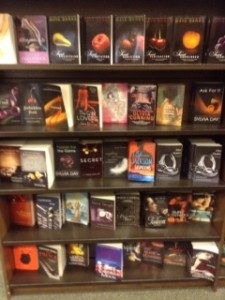I took the following picture at Barnes and Noble the other day:
Do you notice what I notice? That every book is trying to look like Fifty Shades of Gray? What am I saying? Of course you notice. “Domination romance” has taken over the romance market, tied its wrists with silken cord, and demanded that it call this previously non-existant sub-genre “sir.”
I’ve been predicting for a while that fetish romance was going to become mainstream. But this was not how I expected it to happen. What I expected, actually, was that it would all happen in the form of e-books.
See, here’s the problem fetish romance faces: in order to be sold, they have to communicate what they are to the reader. And the established way of doing this is through what I like to call “cover code,” the pictures, palette, and font types on a book’s front cover that indicate what subgenre it belongs to. Over in mystery, a red and black cover, with a thin, spiky font indicates a grisly serial killer mystery; a candy-colored palette, with cartoonish images and a pun in the title, indicates a lighthearted cozy mystery.
In order to sell a spanking romance, a bondage romance, a domination romance, you would need to invent a cover code, because how else would readers know what they were buying? But then the readers would be compelled to carry that cover around with them, everywhere they wanted to read your book. You might be able to read a traditional romance in front of your mother-in-law, fifty people on the bus, or your teenage son—but you are never going to do that with a domination romance. It’s just too weird.
Or so I thought. But evidently there are plenty of people who are willing to pick up Fifty Shades of Gray (or one of its many clones), carry it to the register, pay for it, and, presumably, read it. There are enough of them to move the entire romance market. My prediction, that these types of books would become popular through the oh-so-discreet e-book format, was obviously a big bust.
I was wondering aloud to my husband why this was—had we become a less private people, due to Facebook, blogs, and all this modern sharing? And Mark pointed out that the only way you possibly can create a cover code is in the bookstore.
He’s right. In order for a cover code to work, it must be widely understood by the reading audience. And for that to happen, it must first become prevalent. And the only way it can become prevalent is in public. It has to be seen, and seen widely. It has to enter the public mind.
This difficulty is something for self-publishers to keep in mind. One of the things that excites writers about the new availability of self-publishing is that books that don’t easily fit into a genre are much easier to get out into the world. Writing a cross-genre zombie mystery? A sci fi romance? You can publish it now, and readers can be the judge.
Except, there’s the problem of cover code. On your own, can you establish a cover code? Maybe. Fifty Shades did it. But it did it with the help of an existing Internet fan base and a huge marketing campaign. Most self-publishers aren’t going to have those resources to bring to bear.
And, as more and more self-published books enter the market, are we going to see a dilution of cover code? Self-published books typically have privately produced covers, and if the artist you hire doesn’t understand the cover code for your genre, the cover is likely to be slightly off, slightly confusing, slightly less communicative to potential buyers than the cover produced by a traditional publisher. That’s a problem.
So, no matter how effective e-books are at opening up the world of publishing, I think it’s clear that we writers are not done with the brick and mortar bookstores just yet. They still have a lot to offer us, and a lot to teach us about how to sell.

